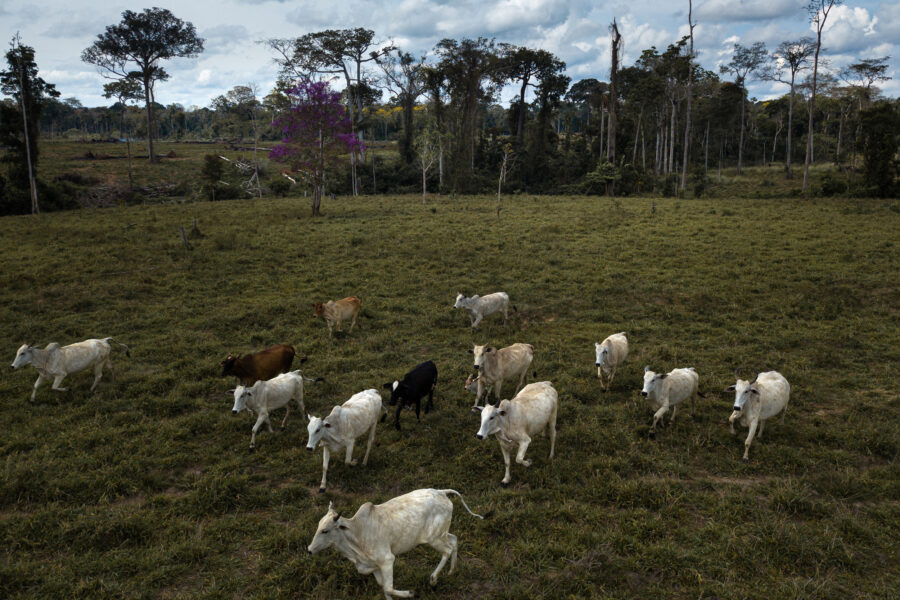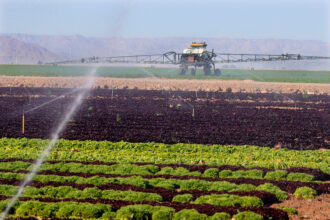Another Midwest Drought Is Causing Transportation Headaches on the Mississippi River
For the third year in a row, extreme drought conditions in the Midwest are drawing down water levels on the Mississippi River, raising prices for companies that transport goods downstream and forcing governments and business owners to seek alternative solutions.
The situation could signal an emerging reality for the region, scientists say, as climate change alters the planet’s weather patterns and inches the average global temperature continually upwards.
“Without question, it’s discouraging that we’re in year three of this. Because that is quite unique to have multiple years in a row of this,” said Mike Steenhoek, executive director of the Soy Transportation Coalition, a trade organization representing Midwest soy growers. “We’re obviously trending in the wrong direction.”
Since 2022, much of the Midwest has experienced some level of drought, with the driest conditions concentrated in Iowa, Missouri, Nebraska and Kansas. Record rainfall in June and during part of July temporarily broke that dry spell, forecasters say, only for drought conditions to reemerge in recent weeks along the Ohio River basin, which typically supplies more water to the Mississippi than any other major tributary.
Explore the latest news about what’s at stake for the climate during this election season.
Water levels have been dropping in the lower Mississippi since mid-July, federal data shows, reaching nearly eight feet below the historic average in Memphis on Thursday. In October 2023, water levels reached a record-low -12 feet in Memphis. Remnants of Hurricane Francine, which made landfall in Louisiana Wednesday night as a Category 2 storm, “will provide only temporary relief,” the National Oceanic and Atmospheric Administration said in a news release Wednesday.
“Rainfall over the Ohio Valley is also not looking to be widespread and heavy enough to generate lasting effects and anticipate that much of the rainfall will soak into the ground with little runoff,” the agency said in the release.
Those conditions have raised prices for companies transporting fuel and grain down the Mississippi in recent weeks, as load restrictions force barge operators to limit their hauls, which squeezes their profit margin. Barge rates from St. Louis reached $24.62 a ton in late August and $27.49 per ton by the following week, according to the U.S. Department of Agriculture.
Steenhoek said barge prices during the week ending Sept. 3 were 8 percent higher than the same week last year and 57 percent higher than the three-year average. “It does change that supply demand relationship,” he said, “because now all of a sudden you’re having to transport a given amount of freight with less capacity.”
Aaron Wilson, Ohio’s state climatologist and a professor at Ohio State University, said the whiplash between this summer’s record wet months and September’s drought conditions appears to fit what could be an emerging climate trend that researchers have observed in recent years.
The Midwest region has generally gotten wetter over the decades. The Fifth National Climate Assessment, released last year, reported that annual precipitation increased by 5 to 15 percent across much of the Midwest in the 30-year period leading up to 2021, compared to the average between 1901 and 1960.
“It does change that supply demand relationship because now all of a sudden you’re having to transport a given amount of freight with less capacity.”
But evidence also suggests the Midwest is experiencing more frequent swings between extreme wet and extreme dry seasons, with climate models predicting that the trend will persist into the future, said Wilson, who was the lead author of the assessment’s Midwest chapter.
“This was front and center for us,” he said. “One of the main things that we talked about were these rapid oscillations … between wet to dry and dry to wet extremes.”
Research also suggests that seasonal precipitation is trending in opposite directions, and will continue to do so in the coming decades, Wilson added. “And so what you get is too much water in the winter and spring and not enough during the growing season,” he said, referring to summer months.
If that evidence holds true, it could have notable impacts on U.S. food exports moving forward.
Transporting goods, including corn, soy and fuel, on the Mississippi is more efficient pound for pound than ground transportation, business groups say, and gives the U.S. an edge in a competitive global market. According to the Waterways Council, a trade association for businesses that use the Mississippi River, a standard 15-barge load is equivalent to 1,050 semi trucks or 216 train cars—meaning domestic farmers and other producers can save significant time and money moving their goods by boat.
The majority of U.S. agricultural exports rely on the Mississippi to reach the international market, as farmers move their crops to export hubs on the Gulf Coast, said Deb Calhoun, senior vice president of the Waterways Council. “More than 65 percent of our national agriculture products that are bound for export are moving on this inland waterway system,” she said. “So this system is critical to farmers of any size farm. You can have a small farm in the middle of the Midwest and you’re able to compete on the world stage.”
The ramifications could be especially harmful to the soy industry, Steenhoek said, since about half of the soy grown in the U.S. is exported. By the last week of August, grain exports transported by barge fell 17 percent compared to the week before, according to a Thursday report released by the USDA.
Steenhoek said the increased costs to U.S. growers hurt their ability to compete globally. Any price increase to domestic grain could encourage international clients to instead buy from rival countries like Brazil or Argentina, he said.
While it’s typical for water levels on the Mississippi to drop during the fall months, Steenhoek said, the recent years of drought have been a real wakeup call for farmers to diversify their supply chains. Soy growers, he said, have since set up new supply chain agreements with rail lines and have even invested in new export terminals in Washington state and on the coast of Lake Michigan in Milwaukee.
Luckily, Calhoun said, disruptions to river transportation this year haven’t been nearly as bad as they were last year, when the Mississippi’s water levels reached record lows. Several barges were grounded last year and in 2022, she said, referring to when boats get stuck on the riverbed or in areas where sediment has built up. That hasn’t occurred so far this year.
She chalks that up to proactive efforts this year by companies and federal agencies, like the Army Corps of Engineers, to mitigate transportation disruptions. The Army Corps, for example, she said, has been dredging the riverbed earlier than normal in anticipation of potential disruptions. Dredging involves moving sediment on the riverbed from areas where it can cause problems to boats to areas where it won’t.
Another silver lining, Calhoun said, is that the droughts have also prompted greater cooperation and collaboration between stakeholders, both public and private. “We have seen even greater cooperation over the last three years with the Corps of Engineers and with the Coast Guard working very much in concert with the industry,” she said.
Wilson, Ohio’s climatologist, said he has also seen stronger cooperation among stakeholders in tackling this issue. “It’s a mix of climate scientists, social scientists and planners and emergency preparedness folks that are really coordinating this effort,” he said.
The result, Calhoun said, is that their coalition of groups have been able to handle the disruptions relatively well this year, which leaves her feeling cautiously optimistic. “It’s really hard, you know, to track this and try to figure out is it just normal? Is it getting much worse? Are we going to have to make significant changes, and if so, what would they be? But we’re not there yet,” she said.
About This Story
Perhaps you noticed: This story, like all the news we publish, is free to read. That’s because Inside Climate News is a 501c3 nonprofit organization. We do not charge a subscription fee, lock our news behind a paywall, or clutter our website with ads. We make our news on climate and the environment freely available to you and anyone who wants it.
That’s not all. We also share our news for free with scores of other media organizations around the country. Many of them can’t afford to do environmental journalism of their own. We’ve built bureaus from coast to coast to report local stories, collaborate with local newsrooms and co-publish articles so that this vital work is shared as widely as possible.
Two of us launched ICN in 2007. Six years later we earned a Pulitzer Prize for National Reporting, and now we run the oldest and largest dedicated climate newsroom in the nation. We tell the story in all its complexity. We hold polluters accountable. We expose environmental injustice. We debunk misinformation. We scrutinize solutions and inspire action.
Donations from readers like you fund every aspect of what we do. If you don’t already, will you support our ongoing work, our reporting on the biggest crisis facing our planet, and help us reach even more readers in more places?
Please take a moment to make a tax-deductible donation. Every one of them makes a difference.
Thank you,
David Sassoon
Founder and Publisher
Vernon Loeb
Executive Editor
Share this article
Disclaimer: The copyright of this article belongs to the original author. Reposting this article is solely for the purpose of information dissemination and does not constitute any investment advice. If there is any infringement, please contact us immediately. We will make corrections or deletions as necessary. Thank you.








